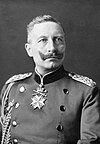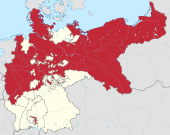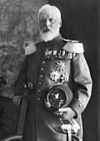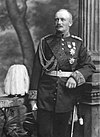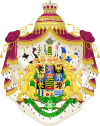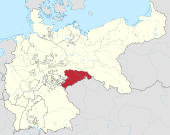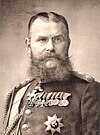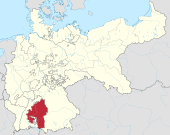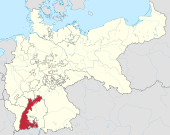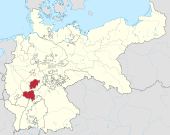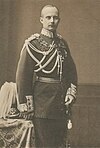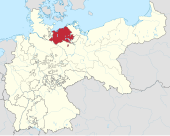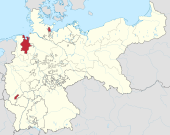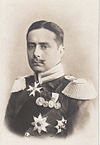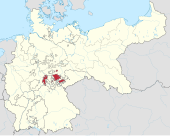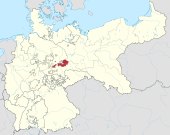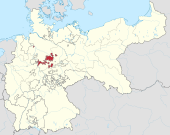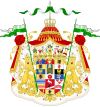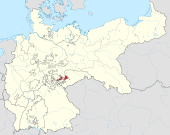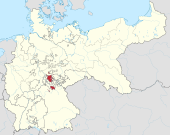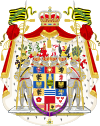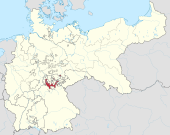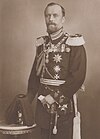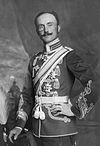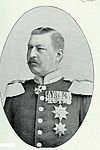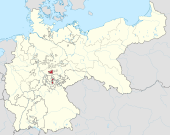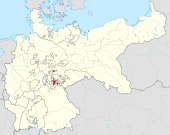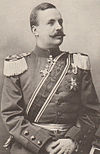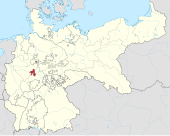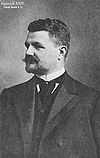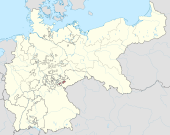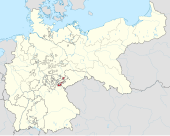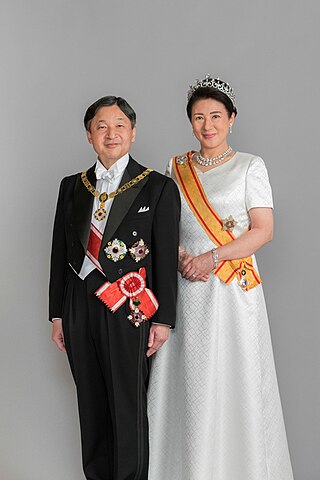
The word emperor can mean the male ruler of an empire. Empress, the female equivalent, may indicate an emperor's wife, mother/grandmother, or a woman who rules in her own right and name. Emperors are generally recognized to be of the highest monarchic honour and rank, surpassing king. In Europe, the title of Emperor has been used since the Middle Ages, considered in those times equal or almost equal in dignity to that of Pope due to the latter's position as visible head of the Church and spiritual leader of the Catholic part of Western Europe. The emperor of Japan is the only currently reigning monarch whose title is translated into English as "Emperor".

The German Empire, also referred to as Imperial Germany, the Second Reich or simply Germany, was the period of the German Reich from the unification of Germany in 1871 until the November Revolution in 1918, when the German Reich changed its form of government from a monarchy to a republic.

The House of Hohenzollern is a formerly royal German dynasty whose members were variously princes, electors, kings and emperors of Hohenzollern, Brandenburg, Prussia, the German Empire, and Romania. The family came from the area around the town of Hechingen in Swabia during the late 11th century and took their name from Hohenzollern Castle. The first ancestors of the Hohenzollerns were mentioned in 1061.

Hohenzollern-Sigmaringen was a principality in southwestern Germany. Its rulers belonged to the senior Swabian branch of the House of Hohenzollern. The Swabian Hohenzollerns were elevated to princes in 1623. The small sovereign state with the capital city of Sigmaringen was annexed to the Kingdom of Prussia in 1850 following the abdication of its sovereign in the wake of the revolutions of 1848, then became part of the newly created Province of Hohenzollern.
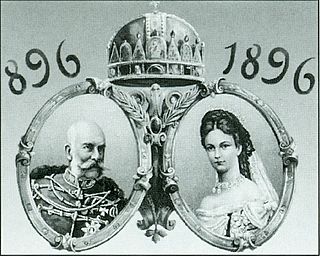
Kaiser is the German title for emperor. In general, the German title in principle applies to rulers anywhere in the world above the rank of king (König). In English, the word kaiser is mainly applied to the emperors of the unified German Empire (1871–1918) and the emperors of the Austrian Empire (1804–1918). During the First World War, anti-German sentiment was at its zenith; the term kaiser—especially as applied to Wilhelm II, German Emperor—thus gained considerable negative connotations in English-speaking countries.

The Year of the Three Emperors, or the Year of the Three Kaisers, refers to the year 1888 during the German Empire in German history. The year is considered to have memorable significance because of the deaths of two German Emperors, or Kaisers, leading to a rapid succession of three monarchs within one year. The three different emperors who ruled over Germany during this year were Wilhelm I, Frederick III and Wilhelm II. The mnemonic "drei Achten, drei Kaiser" is still used today in Germany by children and adults alike to learn the year in question.
German Reich was the constitutional name for the German nation state that existed from 1871 to 1945. The Reich became understood as deriving its authority and sovereignty entirely from a continuing unitary German Volk, with that authority and sovereignty being exercised at any one time over a unitary German "state territory" with variable boundaries and extent. Although commonly translated as "German Empire", the word Reich here better translates as "realm" or territorial "reach", in that the term does not in itself have monarchical connotations.

The emperor of Austria was the ruler of the Austrian Empire and later the Austro-Hungarian Empire. The hereditary imperial title and office was proclaimed in 1804 by Francis II, Holy Roman Emperor, a member of the House of Habsburg-Lorraine, and continually held by him and his heirs until Charles I relinquished power in 1918.
A king-emperor or queen-empress is a sovereign ruler who is simultaneously a king or queen of one territory and emperor or empress of another. This title usually results from a merger of a royal and imperial crown, but recognises the two territories as different politically and culturally as well as in status. It also denotes a king's imperial status through the acquisition of an empire or vice versa.

The German Emperor was the official title of the head of state and hereditary ruler of the German Empire. A specifically chosen term, it was introduced with the 1 January 1871 constitution and lasted until the abdication of Wilhelm II was announced on 9 November 1918. The Holy Roman Emperor is sometimes also called "German Emperor" when the historical context is clear, as derived from the Holy Roman Empire's official name of "Holy Roman Empire of the German Nation" from 1512.

Abdication is the act of formally relinquishing monarchical authority. Abdications have played various roles in the succession procedures of monarchies. While some cultures have viewed abdication as an extreme abandonment of duty, in other societies, abdication was a regular event and helped maintain stability during political succession.
Federal prince was the generic term for the royal heads of state (monarchs) of the various states making up the German Empire, with the exception of the states that were republics and Alsace-Lorraine which had a special status. The empire was a federal state, with its constituent states remaining sovereign states. Among the states, the majority were monarchies, 3 states were republics and Alsace-Lorraine was an imperial territory ruled by a steward. The states became part of the German Empire by an 1871 treaty. The head of the empire was granted the title German Emperor, and was simultaneously a federal prince as King of Prussia, the sovereign of its largest federal state. Of the princely heads of state, 4 held the title King (König), 6 held the title Grand Duke (Großherzog), 5 held the title Duke (Herzog), and 7 held the title Prince. The heads of state of the city republics, where the concepts of nobility and royalty did not exist, were of equal standing to the federal princes and held the titles First Mayor and President of the Senate (Hamburg), Mayor and President of the Senate (Lübeck), and President of the Senate and Mayor (Bremen). The heads of state of the city republics were regarded as primi inter pares among the senators according to the states' republican constitutions, and these states were ruled by an oligarchy of hereditary Grand Burghers, also known as Hanseaten or patricians.

The Monarchy of Germany was the system of government in which a hereditary monarch was the sovereign of the German Empire from 1871 to 1918.

The dissolution of the Holy Roman Empire occurred on 6 August 1806, when the last Holy Roman Emperor, Francis II of the House of Habsburg-Lorraine, abdicated his title and released all Imperial states and officials from their oaths and obligations to the empire. Since the Middle Ages, the Holy Roman Empire had been recognized by Western Europeans as the legitimate continuation of the ancient Roman Empire due to its emperors having been proclaimed as Roman emperors by the papacy. Through this Roman legacy, the Holy Roman Emperors claimed to be universal monarchs whose jurisdiction extended beyond their empire's formal borders to all of Christian Europe and beyond. The decline of the Holy Roman Empire was a long and drawn-out process lasting centuries. The formation of the first modern sovereign territorial states in the 16th and 17th centuries, which brought with it the idea that jurisdiction corresponded to actual territory governed, threatened the universal nature of the Holy Roman Empire.

The abdication of Wilhelm II as German Emperor and King of Prussia was declared unilaterally by Chancellor Max von Baden at the height of the German revolution on 9 November 1918, two days before the end of World War I. It was formally affirmed by a written statement from Wilhelm on 28 November while he was in exile in Amerongen, the Netherlands. The abdication ended the House of Hohenzollern's 500-year rule over Prussia and its predecessor state, Brandenburg. With the loss of the monarchical legitimacy that was embodied by the emperor, the rulers of the twenty-two constituent states of the Empire also relinquished their royal titles and domains.
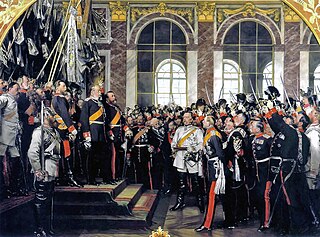
The proclamation of the German Empire, also known as the Deutsche Reichsgründung, took place in January 1871 after the joint victory of the German states in the Franco-Prussian War. As a result of the November Treaties of 1870, the southern German states of Baden, Hesse-Darmstadt, with their territories south of the Main line, Württemberg and Bavaria, joined the Prussian-dominated "North German Confederation" on 1 January 1871. On the same day, the new Constitution of the German Confederation came into force, thereby significantly extending the federal German lands to the newly created German Empire. The Day of the founding of the German Empire, January 18, became a day of celebration, marking when the Prussian King William I was proclaimed German Emperor at the Palace of Versailles, outside Paris, France.

Beginning in 1925, some members of higher levels of the German nobility joined the Nazi Party, registered by their title, date of birth, NSDAP Party registration number, and date of joining the Nazi Party, from the registration of their first prince (Ernst) into NSDAP in 1928, until the end of World War II in 1945.
A Reichsverweser or imperial regent represented a monarch when there was a vacancy in the throne, such as during a prolonged absence or in the period between the monarch's death and the accession of a successor. The term Verweser comes from the Old High German firwesan and means "for or in the place of a person". The plural form is the same as the singular.





